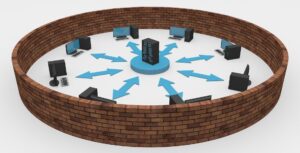
Strategizing the Post-COVID Economy
Pam Sornson, JD
Job development isn’t always an indicator of a robust economy when many of those job openings go unfilled. And unemployment isn’t always a harbinger of a horrible future when those unemployed workers are eager to work. Both circumstances present challenges and opportunities; the trick is to re-envision and restructure them to coordinate with each other. Recrafting job skills to meet emerging job demands solves both problems. It provides workers with the skills they need to find a job and businesses with the skilled workers they require.
California’s current economic situation lends itself to this very concept. Economic disruptions forced millions of people out of work while emerging opportunities leave thousands of companies without the skilled workforce needed to supply them. Fortunately, there’s a plan in place and a program already launched to address these realities, and they both flow through the State’s Community College system.

Economic Disruptions Create Chaos
A triad of major disruptors created chaos across California’s economy over the past 19 months.
The Covid-19 Pandemic
The eruption of the coronavirus in February 2020 almost immediately shut down the State’s economy. The number of unemployed people rose from ~350,000 in March 2020 to a peak of over 4.5 million in May 2020 to where it sits now at approximately 600,000 as of August 18, 2021. However, job openings surged through Spring 2021 as COVID-19 vaccines allowed businesses to open again, which was good news despite impositions of restrictions and capacity limitations. The Coronavirus Delta variant has slowed job growth over the summer, but increased vaccination rates promise to accelerate it again as Fall advances.
Climate Challenges
Climate changes threaten regional economies across the State, too. California’s 2018 fire season cost $150 billion in damages, impacting virtually all industries, from tourism to logistics. Smoke from the fires also affects economies, generating significant air pollution that aggravates existing health concerns. Rising sea levels contribute to economic woes, too. Based on current conditions, billions of dollars of infrastructure and property along the State’s coast are in jeopardy of loss due to elevated water levels. And an increasingly alarming rise in the State’s general temperature threatens everything from California’s agriculture industry to its transportation systems.
Advancing Technology
The coronavirus drove an unprecedented embrace of technology as millions of employees took their work home and embraced their new fully ‘remote’ status. In addition to that growing demand for technological devices, there is also an increase in demand for technicians to manage those devices, maintain their programming, and connect them with the ever-growing cloud-computing sector. Innovations in Artificial Intelligence (AI) and Machine Learning (ML) will further enhance the already burgeoning California IT sector.

Emerging Economic Opportunities
Each of these disruptors caused immense economic damage by shutting down some aspects of the state economy, eliminating millions of jobs and occupations, and forcing an unprecedented overhaul of ‘how work is done’ in millions of businesses. As the pandemic passes, economic experts are evaluating how to recover from its damage by addressing those factors and conjuring new expressions of ‘work’ that will fit in the emerging economic landscape. One such expert is Burning Glass Technologies (BGT), an analytics software company that tracks labor market and industry data.
For its Spring 2021 report, After the Storm, BGT reviewed one billion+ current and historical job postings to determine which jobs and job skills are most likely to dominate the markets as the State recovers from its economic devastation. Their premise is that California can better strategize a recovery from the disruptions by understanding how those impacted individual industries and whole industrial sectors. The State can then direct both effort and investment into plans and programs to build a new economy, not just attempt to replicate the old one.

BGT Conclusions
Fundamentally, BGT projects the addition of 15 to 18 million new jobs across the country over the next five years, which will also compel an immense labor shift. Many of the new occupations will demand different skill sets from those currently in use, and many of those skill sets will require new or additional training than that which is now available. In BGT’s mind, the situation creates a disconnect between existing workforce development capabilities and those that will be needed in the future.
Most notably, BGT surmises that economic growth will flow not just from industrial development but also from the growth of segregated, skill-based ‘economies’ that overlay the traditional industrial structure and will be revenue generators in and of themselves. Their research indicates that today’s required skills sets have changed significantly from those in the past and that technological advances will drive a similar evolution over the next decade. Workers who gain these advancing skills will be highly popular and well paid and can work at virtually the job of their choice in almost any industry.
To better explain the fluidity of the emerging skill sets, BGT describes them in the context of the ‘five economies’ in which they are deployed:
The Automated Economy requires enhanced and evolving technological comprehension, as its technicians design, deploy, and maintain machines to perform mundane tasks with more efficiency and effectiveness than is possible with human labor.
The Green Economy overlays all businesses and industries as it mandates and deploys its environmental policies and practices across all sectors.
The Logistics Economy provides the understructure of manufacturing and transportation productivity to all the world’s industries by ensuring that goods are appropriately packaged, transported, and delivered to global destinations.
The Readiness Economy ensures that societal, physical, and industrial infrastructures remain steady, available, and reliable, such as those in the healthcare, transportation, and public safety sectors.
The Remote Economy offers workers and businesses work-day flexibility that they’ve never before experienced. With no physical tethers to an office, many workers will be able to provide their unique services from any location with a reliable internet connection.
Each of these economies promises remarkable job and industrial growth opportunities for entities that have suffered through the recent economic disruptions. Now is the time to build a responsive workforce development capacity to develop and engage them fully. The State of California has tapped its community colleges to establish those enhanced and enlightened training programs.


